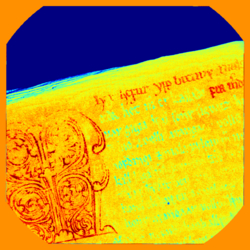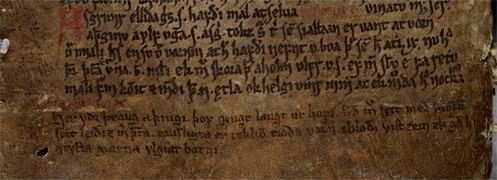Modern technology casts new light on old manuscripts
One of the treasures of the Arnamagnaean Collection is the manuscript AM 468 4to, which dates from the beginning of the fourteenth century and is known by the nickname Reykjabók (‘the book of Reykir’). It contains the oldest complete (but for one leaf) copy of Njáls saga, one of the best known of the Icelandic family sagas (Íslendingasögur).
Like many of the sagas, Njáls saga is prosimetric, i.e. it incorporates a number of verses into the narrative. In Reykjabók many of these stanzas have been written in the margins and at the end of the codex, rather than as part of the main text. Since these added stanzas are in a different hand from that of the main text, scholars have wondered what this could mean regarding the production history of the manuscript, and consequently the transmission history of Njáls saga itself.
The main text was written by a single scribe who included many of the stanzas of Njáls saga but by no means all. In the first part of the manuscript, a total of seventeen additional stanzas were added by another hand. Since these stanzas were written in available spaces around the main text, there is no doubt they must have been written after the main text. On palaeographical grounds, however, the second scribe is considered to be contemporaneous with the first. This gives rise to questions concerning the manuscript’s production: why were some of the stanzas added outside the main text? Did the scribes work together or separately from each other? Where did the added stanzas come from?
Collaborative manuscript production

A fairly simple and straightforward explanation would be that the second scribe independently added more stanzas, potentially some that were newly composed after Reykjabók was written. [1] If that was the case it must have happened fairly soon after the first scribe had finished the main text of the codex. Closer investigation of Reykjabók, however, suggests rather that there was collaboration between the two scribes. New research has revealed that the second scribe was more involved in the basic production processes of Reykjabók than hitherto assumed. [2]
Using both multi-spectral scanning and palaeographic analysis, it can be shown that the second scribe also wrote all the rubrics in the codex, for which space was left by the main scribe. In other words, the first scribe only wrote the main text, which was executed in black ink, and expected another scribe to fill in the red rubrics, for which he made space. While it is of course possible that these rubrics were never filled in during the original production phase of Reykjabók and the second scribe added them independently some time later, it is more compelling to believe that the two scribes collaborated.
The same red ink that the second scribe used for the rubrics as well as in connection with the added stanzas was also identified in the initials. Multi-spectral analysis has revealed that the light red ink used throughout the codex has the same spectral signature, making it very likely that all the light red parts of the manuscript were added in the same scriptorium and presumably at the same time. As it is not possible to analyse the initials palaeographically, it cannot be known for sure if they were drawn by the second scribe or someone else. But as with the rubrics, the main scribe left space for the initials, expected them to be filled in as part of the production process. It was common practice that colourful elements like this were added by another person – at least in large enough scriptoria. Therefore, it seems likely that the main scribe collaborated with the second scribe, who was in charge of decorative aspects and other things apart from the main text.
Where do the verses come from?
When the second scribe worked on the manuscript in order to provide the rubrics and probably also the initials, he also added the extra stanzas, which the main scribe for one reason or another had not included. Accepting that the two scribes collaborated, it becomes less likely that the second scribe had access to stanzas which the first scribe did not have. It is of course possible that at some point during the production process another manuscript of Njáls saga turned up containing additional stanzas, and that since some of the leaves were already written, the new stanzas had to be added outside the main text.
On the other hand, if the former was the case, why did the first scribe not write the stanzas in the same way as he made other corrections to the main text? Given the large number of stanzas in the Reykjabók text -- the largest among the medieval manuscripts of the saga – could the two scribes not have consciously decided to place some of them outside the main body of the text? Could they have planned to have them written by the second scribe along with other features they did not consider to be part of the main text? We will probably never know, but it’s an interesting thought.

On fol. 31v you can see that some stanzas have been added below the main text. (Click on the image for a larger version.)
1) See Guðrún Nordal, “Attraction of Opposites: Skaldic Verse in Njáls saga”, in Literacy in Medieval and Early Modern Scandinavian Culture, red. Pernille Hermann. The Viking Collection 16 (Odense, 2005), 211-236, at 225-226.
2) Beeke Stegmann, “Collaborative manuscript production and the case of Reykjabók: Paleographical and multi-spectral analysis”, in Historia
Contact
Beeke Stegmann is a
E-mail: beeke.stegmann@hum.ku.dk
Reykjabók has been digitized and you can leaf through it here. You can learn more about the history of the manuscript in Ellert Þór Jóhannsson's Manuscript of the Month from May 2015.
